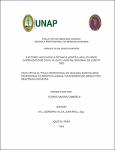Factores asociados a estancia hospitalaria, en niños internados por Covid 19, en el Hospital Regional de Loreto 2020
Abstract
La infección por la COVID-19 ha generado un gran impacto en la mortalidad a
nivel mundial y nacional. El advenimiento de una gran cantidad de casos
respiratorios ha colapsado los sistemas de salud, evidenciando múltiples
defectos en lo administrativo, recursos humanos, infraestructura, oxígeno y
abordaje clínica y terapéutico considerado que es una patología relativamente
poco conocida.
El comportamiento clínico es muy variable y están implicadas variables como
virulencia, nivel de exposición, soporte inmunológico. El espectro de gravedad
varía desde formas asintomáticas hasta críticas. En población pediátrica, la gran
cuestión es reconocer con cuánta severidad puede comportarse en niños. Hasta
hoy se sabe, que el curso de la enfermedad suele ser leve o asintomático; sin
embargo, constituyen potenciales focos de contagio. Conocer esto no exime de
que los pacientes pediátricos no presenten complicaciones severas que
requieran hospitalización necesariamente. Hasta un 5.7% de pacientes
pediátricos requieren hospitalización por COVID-19.
Identificar los potenciales factores de riesgo relacionados al paciente y el
comportamiento de la enfermedad como factores asociados a estancia
hospitalaria permitirá incidir sobre estos para disminuir las probabilidades de
mayor afectación. Nuestra población pediátrica también ha padecido muertes,
secuelas y morbilidad persistente por esta enfermedad. Esto da material de
estudio para caracterizar el comportamiento clínico, acercarnos a entender qué
factores influyen en estancias hospitalarias prolongadas o en desenlaces fatales
en nuestros niños.
El presente estudio es de tipo analítico, observacional, multivariado y
retrospectivo. Se incluirán todos los pacientes menores a 15 años ingresados en
cualquier servicio relacionado al departamento de Pediatría del Hospital Regional
de Loreto con diagnóstico de COVID-19. Una vez seleccionados, se disgregarán
en dos grupos: aquellos con estancia hospitalaria menor a 7 días y aquellos con
estancia mayor a 7 días. Una vez obtenidos los datos, serán sometidos análisis
estadístico mediante el programa SPSS. Se aplicará el análisis de factores de
riesgo mediante análisis logístico binario, que incluye razón de momios (OR)
considerando estadísticamente significativo un valor de p<0.05.
Los recursos humanos, institucionales y económicos son viables y factibles y
serán asumidos por la autora de la presente investigación. The COVID-19 infection has had a great impact on mortality globally and
nationally. The advent of a large number of respiratory cases has collapsed the
health systems, evidencing multiple defects in the administrative, human
resources, infrastructure, oxygen and clinical and therapeutic approach,
considered to be a relatively little known pathology.
The clinical behavior is highly variable and variables such as virulence, level of
exposure, immunological support are involved. The spectrum of severity ranges
from asymptomatic to critical forms. In the pediatric population, the big question
is to recognize how severely it can behave in children. Until today it is known that
the course of the disease is usually mild or asymptomatic; however, they
constitute potential sources of contagion. Knowing this does not exempt pediatric
patients from presenting severe complications that necessarily require
hospitalization. Up to 5.7% of pediatric patients require hospitalization for COVID-
19.
Identifying the potential risk factors related to the patient and the behavior of the
disease as factors associated with hospital stay will allow influencing these to
reduce the chances of further involvement. Our pediatric population has also
suffered deaths, sequelae, and persistent morbidity from this disease. This
provides study material to characterize clinical behavior, to get closer to
understanding what factors influence prolonged hospital stays or fatal outcomes
in our children.
The present study is analytical, observational, multivariate and retrospective. All
patients under 15 years of age admitted to any service related to the Department
of Pediatrics of the Hospital Regional de Loreto with a diagnosis of COVID-19 will
be included. Once selected, they will be broken down into two groups: those with
a hospital stay of less than 7 days and those with a stay of more than 7 days.
Once the data are obtained, they will be subjected to statistical analysis using the
SPSS program. Risk factor analysis will be applied using binary logistic analysis,
which includes odds ratio (OR) considering a value of p <0.05 statistically
significant.
Human, institutional and economic resources are viable and feasible and will be
assumed by the author of this research.
Collections
- Segunda Especialidad [37]


